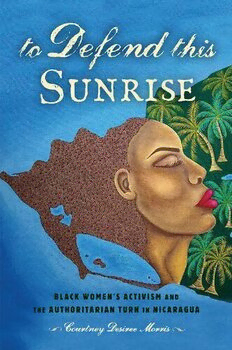
To Defend This Sunrise: Black Women’s Activism and the Authoritarian Turn in Nicaragua PDF
Preview To Defend This Sunrise: Black Women’s Activism and the Authoritarian Turn in Nicaragua
TO DEFEND THIS SUNRISE TO D EFEN D TH IS SU N RISE Black Women’s Activism and the Authoritarian Turn in Nicaragua courtney desiree morris rutgers university press New Brunswick, Camden, and Newark, New Jersey London and Oxford, UK Rutgers University Press is a department of Rutgers, The State University of New Jersey, one of the leading public research universities in the nation. By publishing worldwide, it furthers the University’s mission of dedication to excellence in teaching, scholarship, research, and clinical care. Library of Congress Cataloging-in-Publication Data Names: Morris, Courtney Desiree, author. Title: To defend this sunrise : Black women’s activism and the authoritarian turn in Nicaragua / Courtney Desiree Morris. Description: New Brunswick, New Jersey : Rutgers University Press, [2023] | Includes bibliographical references and index. Identifiers: LCCN 2022009353 | ISBN 9781978804791 (paperback) | ISBN 9781978804807 (hardback) | ISBN 9781978804814 (epub) | ISBN 9781978804838 (pdf) Subjects: LCSH: Women, Black—Political activity—Nicaragua—Bluefields. | Civil rights—Nicaragua. | Multiculturalism—Nicaragua. | Black people—Nicaragua— Politics and government. | Indigenous peoples—Nicaragua—Politics and government. | Nicaragua—Politics and government—1990- Classification: LCC HQ1236.5.N5 M67 2023 | DDC 305.80097285—dc23/eng/20220404 LC record available at https://lccn.loc.gov/2022009353 A British Cataloging- in- Publication rec ord for this book is available from the British Library. Copyright © 2023 by Courtney Desiree Morris All rights reserved No part of this book may be reproduced or utilized in any form or by any means, electronic or mechanical, or by any information storage and retrieval system, without written permission from the publisher. Please contact Rutgers University Press, 106 Somerset Street, New Brunswick, NJ 08901. The only exception to this prohibition is “fair use” as defined by U.S. copyright law. References to internet websites (URLs) were accurate at the time of writing. Neither the author nor Rutgers University Press is responsible for URLs that may have expired or changed since the manuscript was prepared. The paper used in this publication meets the requirements of the American National Standard for Information Sciences— Permanence of Paper for Printed Library Materials, ANSI Z39.48-1992. www . rutgersuniversitypress . org Manufactured in the United States of Amer i ca For my Bluefields sistren. Don’t give up the fight. CONTENTS Preface: An Unexpected Uprising? ix Introduction: Black Women’s Activism in Dangerous Times 1 part i: genealogies 1 Grand Dames, Garveyites, and Obeah W omen: State Vio lence, Regional Radicalisms, and Unruly Femininities in the Mosquitia 33 2 Entre el Rojo y Negro: Black Women’s Social Memory and the Sandinista Revolution 63 part ii: multicultural dispossession 3 Cruise Ships, Call Centers, and Chamba: Managing Autonomy and Multiculturalism in the Neoliberal Era 95 4 Dangerous Locations: Black Suffering, Mestizo Victimhood, and the Geography of Blame in the Strug gle for Land Rights 125 part iii: resisting state vio lence 5 “See how de blood dey run”: Sexual Vio lence, Silence, and the Politics of Intimate Solidarity 153 6 From Autonomy to Autocracy: Development, Multicultural Dispossession, and the Authoritarian Turn 180 Conclusion: Transition in Saeculae Saeculorum 210 Acknowl edgments 219 Notes 223 References 237 Index 257 vii PREFACE An Unexpected Uprising? In April 2018 Nicaragua was shaken by a wave of popul ar protest against the administration of President Daniel Ortega and his wife and vice president Rosa- rio Murillo. In the weeks and months that followed, hundreds of thousands of Nicaraguans— university students, retirees, environmentalists, feminists, religious leaders, Black and Indigenous communities, journalists, and left-w ing and right- wing opposition groups— flooded the nation’s streets calling for Ortega’s resigna- tion and early elections. The unfolding crisis took many, including the government, by surprise (Semple 2018). Yet the conditions for this uprising had been in the making for more than a de cade and revealed a deepening crisis of legitimacy for the Ortega administration (Baltodano 2014; Bendaña 2007; Chamorro 2016; Her- rera Vallejos 2018; Jarquín et al. 2016; La Semana 2016; Martí i Puig 2013; Rocha 2016; Ruiz 2016; Salinas Maldonado 2017; Téllez 2012; Velasco 2017). On April 18, Ortega issued an executive order, bypassing the National Assem- bly, that instituted a series of reforms to the Nicaraguan Social Security Institute (INSS).1 The reforms would increase the amount that employees and employers would have to pay into the system while cutting benefits to eld erly retirees by 5 percent (“Publican Reformas al INSS en La Gaceta” 2018a; Semple 2018). The public outcry was “swift and furious” (Anderson 2018). Retirees began protesting outside the offices of the INSS. They were quickly joined by university students from the Central American University (UCA) and the Polytechnic University of Nicaragua (UPOLI), many of whom had participated in protests over the govern- ment’s mishandling of a massive wildfire in the Indio Maíz Biological Reserve on the Ca rib bean coast earlier that month (Salazar 2018a). The government’s reaction rapidly escalated into violent repression. It shut down tele vi sion stations broad- casting live coverage of the protests, ordered anti- riot police forces to disperse the demonstrations by firing live rounds into crowds of protesters, engineered the mass arrests of student activists, and attacked universities where students were mobilized. Pro- Sandinista gangs, known as turbas, and members of the Sandinista Youth also attacked demonstrators with mortars and other arms as the National Police stood by and refused to intervene (Amnesty International 2018; IACHR 2018; Moncada and Chamorro 2018; United Nations 2018a, 2018b). By the end of the first week of protests, the Nicaraguan Center for H uman Rights (CENIDH) confirmed forty-t hree deaths and two p eople in critical condition. Other groups, relying on official and unofficial reports, estimated as many as sixty deaths (“Organismos Continúan Registro de Víctimas” 2018b). Among the dead was Ángel Gahona, a journalist who was shot and killed while livestreaming ix
